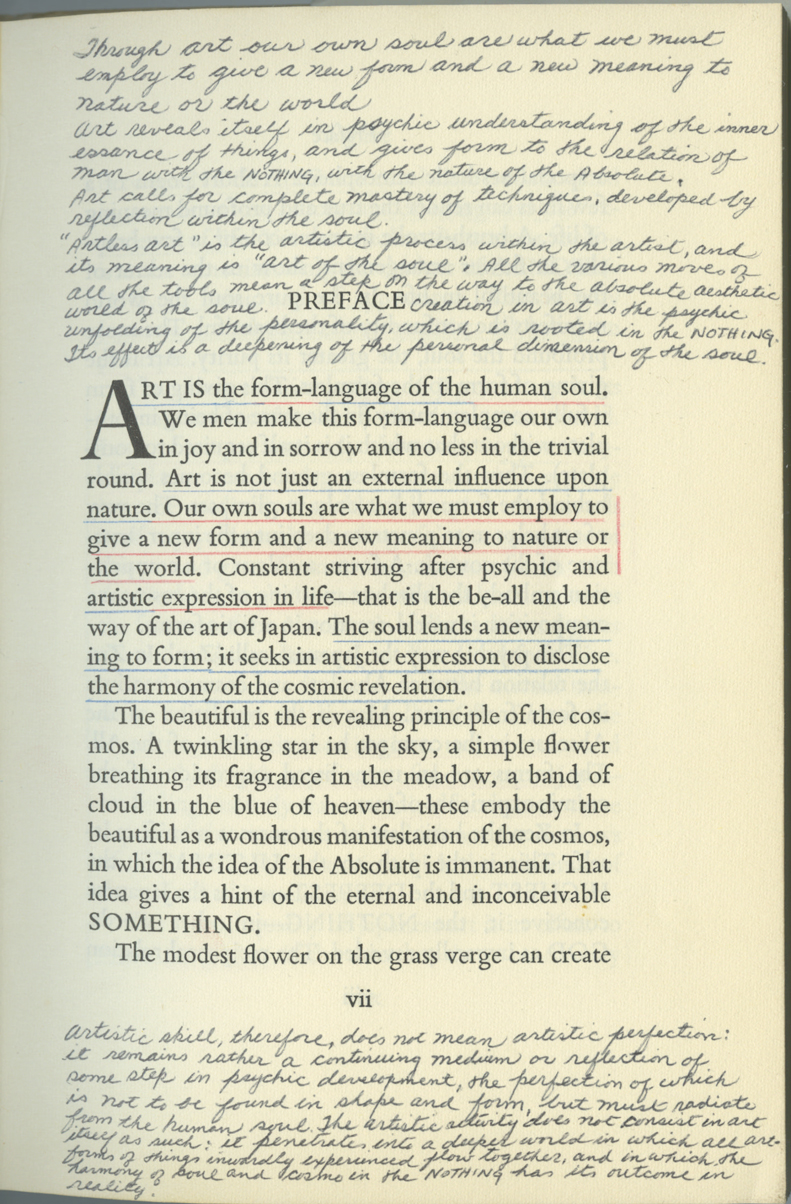#136 Bruce Lee Library - Zen in Japanese Art
We return to Bruce Lee’s Library to examine another book that greatly influenced Bruce Lee’s philosophy. Bruce would underline and annotate his books, and would journal about them creating his own version of a book report after reading. In his volume of
Zen in Japanese Art, A Way of Spiritual Experience by Toshimitsu Hasumi, Bruce highlighted passages, made notes throughout, and wrote a long note at the beginning of the book.
This book, Zen in Japanese Art, A Way of Spiritual Experience by Toshimitsu Hasumi, is about the notion that Japanese Art, or Zen in Japanese art, is a spiritual experience that is connected to nature, the Tao, the artist, and the viewer of the art. There is a spiritual essence woven within the art so that through the simple nature of the art much more can be felt.
The first excerpt that Bruce Lee highlighted in this book is:
“Art is the form-language of the human soul.”
In the confines of this book the author is talking about fine art, but in Bruce Lee’s philosophy art is expressing one’s soul out in the world in our individual ways, even if the art is simply the creating one’s own life. For Bruce Lee, his art was a physical art as it was a martial art. Your own soul should speak through your creation.
“The soul lends a new meaning to form; it seeks in artistic expression to disclose the harmony of the cosmic revelation.”
“Art is the giving of form to the formless.”
“Art helps us to penetrate deep into the inner structure of the cosmos.”
All of these quotes that Bruce Lee underlined connect to his own creation and cultivation of himself and his art of Jeet Kune Do. These quotes also connect to Bruce’s thoughts on how one must be one with nature as well as his thoughts on the formless form, the void, and the nothing.
“Love of nature not only shows the way to contemplative transcendence: even more it is a guide into the meditative world of the spirit.”
“Outward technique by itself is not art. It is only through long training of the soul that the pupil is brought to the true inward technique.”
Bruce Lee had many of his own writings where he stated that art is the reflection of the soul, and that the artist should have mastery over themself to be at the height of their discipline.
It is interesting that Bruce Lee, a Chinese man, would possess and study a book on Japanese art because on the surface level it seems to have nothing to do with what he was pursuing. However, he highlighted this passage that indicates the value he saw in the study of other cultures: “The very endeavor to understand a foreign culture develops the comprehensiveness and liveliness of the capacity for understanding one’s own tradition.”
“The most important aesthetic principle is harmony.”
“Culture… is a system constructed by the free soul, built up on the basis of nature by means of personal actions and laying claim to universal understanding.”
“The more deeply grounded the artist’s soul, the more original it is.”
All of these underlined quotes really point towards the core parts of Bruce Lee’s philosophies relating to living authentically, self-actualization, honestly expressing oneself, and being a free soul.
“Philosophers, men of learning, and masters in all branches of art must first be masters of living, for the soul creates everything.”
In this book, the author is talking about how in order for the art to be spiritual, and a spiritual experience for everyone, the artist has to be a master of life who has done the work of soul searching so as to be the channel for the art.
In all of these highlighted sections, the art is described as the process not as the product of the artist.
“Art is an eternal way that can never be completed, and finds neither satiety nor fulfillment.”
“…art is the way to the Absolute and to the essence of human life.”
Even though all of these quotes are describing art, they can be applied to the creation of one’s own life.
The creation of harmony in your life is a life-long process it is never finished.
“Everything is unstable and subject to change, and only when the self returns to the higher Self is truth perceived, attained, and experienced.”
**“The ten steps in the experience of truth in the DO:
- Seeking and striving after truth:…with a view to grasping everything essential
- Awareness of truth:…a definite attitude of mind is required
- Perception of truth
- Understanding of truth
- Experiencing of truth
- Mastering truth
- Forgetting truth
- Forgetting the carrier of truth
- Return to the primal source where truth has its roots
- Repose in the Nothing”**
“The aim of art, however, is not the one-sided promotion of spirit, soul, and sense, but the opening of all human capacities – thought, feeling, and will – to the life rhythm of the world of nature: so will the voiceless voice be heard and the self be brought into harmony with it.”
On the first page of this book, Bruce wrote the following notes:
“Through art our own soul are what we must employ to give a new form and a new meaning to nature or the world. Art reveals itself in psychic understanding of the inner essence of things, and gives form to the relation of man with the NOTHING, with the nature of the Absolute. Art calls for complete mastery of techniques, developed by reflection within the soul. “Artless art” is the artistic process within the artist, and its meaning is “art of the soul”. All the various moves of all the tools mean a step on the way to the absolute aesthetic world of the soul. Creation in art is the psychic unfolding of the personality, which is rooted in the NOTHING. Its effect is the deepening of the personal dimension of the soul. Artistic skill, therefore, does not mean artistic perfection: it remains rather a continuing medium or reflection of some step in psychic development, the perfection of which is not to be found in shape and form, but must radiate from the human soul. The artistic activity does not consist in art itself as such: it penetrates into a deeper world in which all art forms of things inwardly experienced flow together, and in which the harmony of soul and cosmos in the NOTHING has its outcome in reality.”
Write to us at hello@brucelee.com or tag us @brucelee on social media with #bruceleepodcast.




